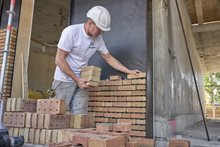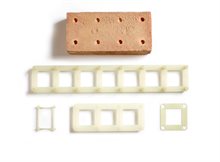
A mortar-free future of bricklaying
Dennis launched his career in 2004 as an entrepreneur in bricklaying and scaffolding. He quickly realized that the traditional approach wasn’t built for the future. Training a bricklayer took 18 months and cost €150,000 — clearly, something had to change. Starting with a blank sheet of paper and a bold idea, Dennis developed a system that could be learned in just two weeks, uses no cement, and is applicable worldwide. It’s sustainable, demountable, and future-ready.
But how do you transform a centuries-old building tradition with a single, simple innovation?
So, what exactly does Drystack do?
Drystack offers a smart alternative to traditional bricklaying. It’s a dry-stacking system — a method of building with bricks without using mortar (no lime, cement, sand, or water required).
Are you curious if your development question fits TNO Fast Track approach? Take the Quick Scan to find out(opens in a new tab) (refers to another website) (opens in a new tab) (refers to another website).
What is the challenge with traditional bricklaying?
There are several. The first challenge relates to the profession itself. The number of bricklayers is rapidly declining — from 26,000 in 1990 to just 6,500 today. It’s becoming a dying trade, much like that of thatchers. New entrants are scarce, and training a bricklayer takes a long time: about 18 months. On top of that, the work is physically demanding, repetitive, and labor-intensive. It also poses health risks, such as exposure to quartz dust from dry mortar, which can lead to lung fibrosis — commonly known as “dust lungs.” The more exposure, the greater the damage. And with around 500 million façade bricks produced annually for the Dutch market, this is a very real concern for the industry.
The second challenge is weather dependency. Heavy rain washes away mortar, and frost causes it to freeze — both halting production. This directly affects labor productivity, which is a key concern for contractors.
Finally, sustainability plays a major role. Traditional bricklaying has a significant environmental impact, especially due to the CO₂ emissions from cement production. In public tenders, sustainability is increasingly measured using the Environmental Cost Indicator (MKI), expressed in euros per square meter. The lower the MKI score, the less environmental impact. In some tenders, only 5% of the total bid amount may be allocated to the MKI score — making low-impact solutions more competitive.
How does Drystack technology work — and why is it a game-changer for construction companies?
Drystack uses a dry-stacking system that eliminates the need for mortar. Instead of relying on traditional materials like cement, lime, sand, and water, bricks are stacked using a precision-engineered interlocking method. This makes the process faster, cleaner, and more efficient.
For construction companies, the benefits are clear:
- Speed – Projects move faster with no drying time required.
- Flexibility – Weather delays are minimized since there's no mortar to wash away or freeze.
- Health & Safety – Workers avoid exposure to harmful dust from dry mortar.
- Sustainability – The system significantly reduces CO₂ emissions by cutting out cement.
- Cost-efficiency – Lower training time and reduced labor intensity lead to savings.

Stacking bricks offers several advantages for contractors, architects, and developers. For contractors and architects, it’s a scalable, circular, and sustainable solution. The process is more predictable and not dependent on weather conditions, which improves cost efficiency. It also reduces weight and results in a much cleaner construction site.
How big is your target market?
The potential is enormous! In the Netherlands, we currently have a market share of around 1 million bricks. Our goal is to reach 10% of the total number of bricks produced nationally — roughly between 50 and 100 million. We're doing this by developing Drystack as an asset-light, license-based company. With a global patent in place, anyone can use our machines and plastic layers.
Our first priority is to become a commodity in the Dutch market before actively expanding into Europe. And the opportunities are huge — the UK market, for example, is 5 to 8 times larger than the Dutch market, and many Dutch bricks are already exported there.
We’re truly in the scale-up phase. We're learning fast — both from the technology and the market — and we're currently focused on delivering high-quality projects to prove the concept.
Where does your technical solution currently stand?
We have strong confidence in our system, but of course, we must comply with laws, regulations, and certification standards. In the Netherlands, technological innovations like Drystack are certified by several accredited bodies. This process is carried out by European-accredited organizations such as KIWA, ensuring our solution meets all necessary requirements.
To meet certification requirements, our system must pass a series of rigorous tests. These include bending tests, freeze-thaw cycles, compression and tensile strength tests, thermal shock tests, and fire resistance evaluations. In the fire test, for example, a façade built using Drystack’s plastic layers and precision-milled bricks is subjected to extreme conditions to assess its performance.
How has TNO helped so far?
We’ve already had our plastic components tested by an independent research institute to assess their long-term durability — especially under continuous stress. The tests examined whether the material could degrade over time due to heat, sunlight, moisture, and pressure. As expected, the results were highly positive, confirming the material’s resilience and suitability for long-term use.
Our next step is to have Drystack included in the BRL (Assessment Guideline). The standards committee has asked us to have the same tests conducted by TNO, a leading Dutch research organization.
TNO exposes the material to high temperatures, moisture, and often UV light over various time periods. During and after testing, they measure how strong and stiff the material remains, and whether any chemical changes occur. Based on this data, they predict how long the material can be safely used. The result is a detailed report with insights into the material’s lifespan. After that, they prepare test samples and accelerate the aging process in a controlled lab environment.
Are you satisfied with TNO Fast Track so far?
So far, yes. Working with Ruben from the TNO Fast Track team has been refreshingly direct and well-structured. Everything feels highly efficient — and that’s exactly what I value as an entrepreneur. Every meeting is focused on decision-making, allowing us to move forward quickly as a company.
About TNO Fast Track
Do you have a challenge where you could use TNO’s specialized knowledge and R&D? Through TNO Fast Track, we are your independent technology partner for startups, scale-ups, and innovative SMEs. Schedule an intake with TNO Fast Track, and we’ll get in touch quickly to accelerate your innovation together.
